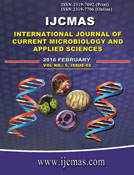


 National Academy of Agricultural Sciences (NAAS)
National Academy of Agricultural Sciences (NAAS)

|
PRINT ISSN : 2319-7692
Online ISSN : 2319-7706 Issues : 12 per year Publisher : Excellent Publishers Email : editorijcmas@gmail.com / submit@ijcmas.com Editor-in-chief: Dr.M.Prakash Index Copernicus ICV 2018: 95.39 NAAS RATING 2020: 5.38 |
Fecal environment in conjunction with the pastures act as a sort of "incubator" and reservoir propagator for infective larvae (L3) belonging to nematode parasites. In this sense, the use of antagonists that can act to control the development of nematodes in stool is welcome. In the present the nematophagous fungus Duddingtonia flagrans (AC001) was used. The objective of this study was to use the fungus Duddingtonia flagrans in the biological control of the development of nematode larvae in equine stool. Feces from parasited equine raised on pasture in a rural property in the south east region of Espirito Santo - Brazil were used during the months of July to August 2015. Then, the fecal samples were separated into two equidistant locations where they were divided into a control group and a group treated with fungus. Weekly, in the treated group, 2 mL of the fungus with an approximate concentration of 1,000 chlamydospores was added. In the control group 2 mL of distilled water was added. Next, from each stool sample, in each group, total fecal masses were collected for further analysis of EPG, stool cultures, and later the Baermann for L3 reduction analysis. The dynamics of the experiment was based on the addition of fungus and or distilled water, collection of total fecal mass, followed by replacement of the fecal boli from the treated and control groups with positive stool for equine gastrointestinal nematodes. The results demonstrated that the larvae mean counts for the control group were higher than the average L3 retrieved from the group treated with AC001 (p<0.01). The L3 reduction percentage retrieved from the group treated with AC001 was 48.2% in relation to the control group. The results of this study point to the need for further research to be carried out involving the biological control for nematode population dynamics in equine stool.
 |
 |
 |
 |
 |